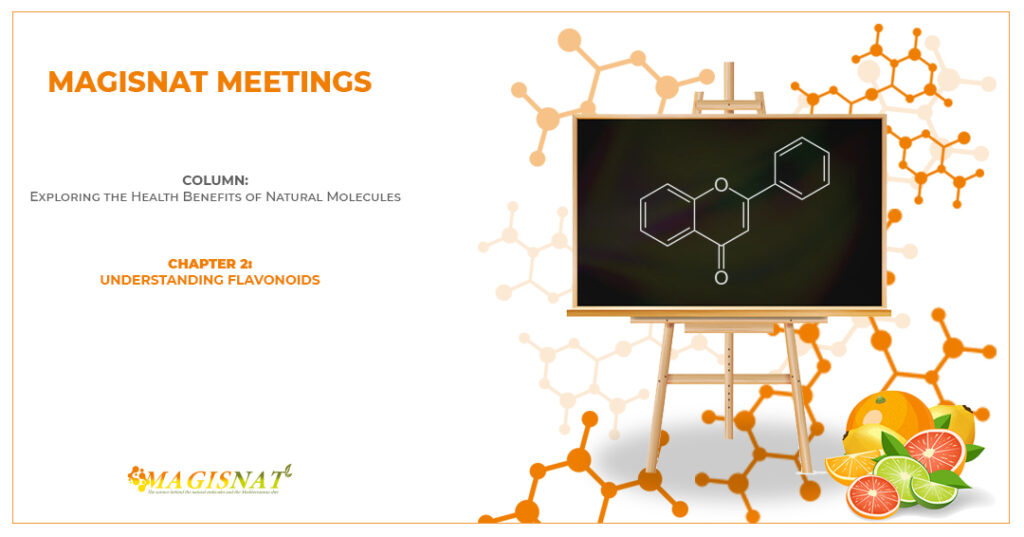Introduction:
Flavonoids, a diverse group of plant compounds, have captured the attention of MAGISNAT’s researchers for their potential health benefits. This article aims to provide a comprehensive overview of flavonoids, including their chemical structure, sources in nature, and their significant role in human health.
What are Flavonoids?
Flavonoids belong to a class of polyphenolic compounds found abundantly in fruits, vegetables, grains, herbs, and beverages such as tea and wine. Structurally, flavonoids are characterized by a distinctive C6-C3-C6 carbon skeleton, comprising two phenyl rings (known as A and B rings) connected by a three-carbon chain forming the C ring. This fundamental structure is the foundation for the vast array of flavonoid subclasses, each distinguished by specific modifications such as hydroxylation, methylation, glycosylation, or prenylation. These structural variations impart unique chemical properties and biological activities to different flavonoid compounds, contributing to their diverse roles in human health and disease prevention.*
The structural diversity of flavonoids extends beyond their core carbon framework to include variations in side chains, ring substitutions, and conjugated double bonds, which influence their solubility, stability, and bioavailability. These structural modifications also dictate the interactions of flavonoids with biological targets such as enzymes, receptors, and cellular signaling pathways, thereby modulating their pharmacological effects and therapeutic potential.
Sources in Nature:
Flavonoids are widely distributed across botanical specimens, lending their distinctive hues to fruits and flowers alike. Synthesized through the phenylpropanoid pathway within plant cells, flavonoids undergo a complex biochemical journey, ultimately manifesting in their diverse chemical structures and biological activities.
Diverse botanical treasures serve as reservoirs of flavonoids, offering a rich assortment of these phytochemicals to discerning palates. Citrus fruits, such as oranges and lemons, contribute their tangy zest and vibrant colors, while berries like blueberries and strawberries entice with their sweet succulence and antioxidant potency. Apples, with their crisp texture and diverse cultivars, offer a palatable source of flavonoids, while onions impart their pungent flavors and phytochemical richness to culinary creations. Additionally, cocoa, extracted from the seeds of Theobroma cacao, and green tea, derived from Camellia sinensis leaves, provide flavonoids. The composition and concentration of flavonoids in these botanical specimens enrich the human diet.
Role in Human Health:
Flavonoids have gained attention for their potential health-promoting effects, attributed to their antioxidant and anti-inflammatory properties. As potent antioxidants, flavonoids scavenge free radicals and reduce oxidative stress, thereby protecting cells from damage and lowering the risk of chronic. Moreover, flavonoids exhibit anti-inflammatory activity by modulating various signaling pathways involved in inflammation and immune response, contributing to the prevention of inflammatory.*
Conclusion:
In conclusion, flavonoids represent a fascinating class of plant compounds with diverse chemical structures and potent biological activities. Their widespread presence in nature and potential health benefits underscore the importance of incorporating flavonoid-rich foods into a balanced diet. Further research is needed to elucidate the mechanisms underlying the health effects of flavonoids and to explore their therapeutic potential in preventing and managing various conditions.*
About MAGISNAT
MAGISNAT, headquartered at Atlanta Tech Park in Peachtree Corners, GA, is a pioneer in personalized wellness solutions. Specialize in Omics Tests, including genomic, metabolomic, and proteomic tests, designed to explore key biochemical pathways for personalizing lifestyles and dietary supplementation. MAGISNAT’s product lines consist of scientifically studied formulations, offering an integrated approach through Omics Pathway Analysis.*
Media Contact
Company Name: MAGISNAT OMICS LLC
Contact Person: Matteo Bertelli MD, PhD
Email: info@magisnat.com
Address: Atlanta Tech Park 107 Technology Parkway Suite 993
City: PEACHTREE CORNERS
State: GA 30092
Country: United States
Website: Magisnat.com
*These statements have not been evaluated by the Food and Drug Administration. It is important to note that this article does not intend to provide medical advice, and the purpose of the summary of scientific bibliography is cultural insight. The article does not suggest that macronutrients have any therapeutic, diagnostic, or preventive properties for any disease or condition. It is not intended as advice to use macronutrients in any modality or for any purpose. Only a physician and/or nutritionist can provide advice in the areas of nutrition, prevention, and health.

